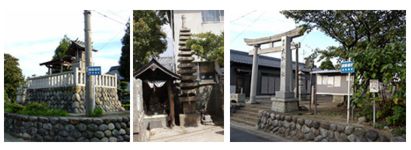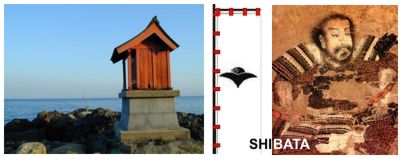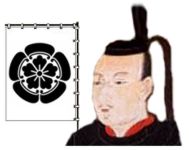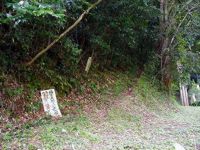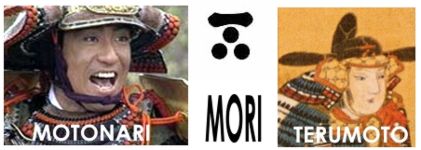ODA NOBUNAGA'S
OTHER WARS
IN
CHRONOLOGICAL ORDER
Click here for detailed and complete maps of Japan, all the provinces and warlords.
| PAGE 1 | PAGE 2 |
The earthshaking victory at the Okehazama battle (see another page at this section) hadn't yet died down in memory, when Oda Nobunaga got a breaking news that his brother in-law, Lord Saito Yoshitatsu of Mino, just died. It was June 1561. The new Chief of the Saito clan was an entirely clueless teenager named Saito Tatsuoki, who seemed to have chosen a career of inert delinquency, so everything was suddenly clear to the 27 years-old Oda Nobunaga -- he had to get Mino in whichever way. It was his father in-law's domain anyway to start with (click here for story and pictures). This late father in-law Saito Dosan, who was actually even more eccentric than Oda Nobunaga was, spent the last years of his life in war against his step-son Yoshitatsu. The ugly battles of Mino between these Saitos had irritated Oda to no end -- in his opinion, both the father and the son weren't fit to rule, so why clawing each other up? From Mino, Oda could spread his territorial claim to any direction. He didn't have to contemplate anything that day; all had been at the back of his mind since 1550's. The next thing he did after receiving the news was calling up his Generals and delivering orders to march across Mino's borders. Saito Tatsuoki's youth can't be an excuse for his immediate internal mismanagement and overall neglect (Oda Nobunaga, Tokugawa Ieyasu, and everybody else got the same position when they were teenagers, too, remember?). So one by one the Saito Generals defected, and Toyotomi Hideyoshi netted them all.
But that was later. In 1561, the Saito clan still got the appearance of being the same old clan, so Oda Nobunaga didn't take any chances and dragged all soldiers that he got around Kiyosu into Saito's domain. Saito only sneered at the small force -- no more than 5,000 men -- and they got a battle in the riverside of Sunomata (click here for pictures). Saito lost not just in the battle but also in geographic terms; the Sunomata area was now in Oda Nobunaga's possession. And it was a strategic position to launch attacks toward Mino from. Oda wanted to make it a base for his next manoevers. So he told Toyotomi Hideyoshi and Hachisuka Hikoemon to go there, with just the small band of Hachisuka's clansmen because Oda couldn't spare any more of his still stunted number of manpower, and build something that made sense at the spot. What he gave was just this order. The rest was Toyotomi's thing to get headache from. But he, as always, made the Mission Impossible seemed like a weekend at the Bahamas.
This was a nasty and gory springtime campaign. It was always be, whenever the Oda Army fought against the warrior-monks. In Nagashima, there were hordes of them in the marshy landmasses, alert and ready to strike, persevering in bad times, sustained by a blazing collective hatred of Oda Nobunaga -- something mutual. Oda Nobunaga himself didn't lead the expedition into what would be recorded in history as a costly failure. He was busy warring against other clots of warriors-monks closer to home (click here). The 10,000 soldiers or more were led by Oda's best General Shibata Katsuie, backed-up by two of the best Oda Captains under Shibata's command, Hachisuka Masamoto and Ujiie Bokuzen. But even these names, which could scare anyone at the time into fitful sleep, were not enough. The Nagashima warrior-monks and sectarian fanatix in the area had known the day would come, so they got prepared since a long way back. The unwelcoming marshes were tailed now by strong fortification that Shibata's men couldn't break through. Both Hachisuka and Ujiie died fighting, and Shibata himself had to be taken back to the Oda HQ and straight into the E.R.
The mighty Takeda clan of Kai was no more, or sort of. In June 1575, Takeda Katsuyori was whacked so badly by Oda Nobunaga at the Nagashino battle (click here), and virtually every fine warrior of Kai had been R.I.P. General Oda Nobutada, Nobunaga's heir, didn't get home when the battle was over. He led his army to do what would make his daddy happy: crushing the last part of the Minoan chain so that the entire province would be the Oda clan's for real.
And this meant the obtrusive and stubborn castle of Iwamura, a Takeda fort within Oda's province. This seemingly insignificant fort was an eyesore to Oda Nobunaga. It was manned by 3,000 soldiers, and its commander, Akiyama Nobutomo, who snatched it for the Takedas, already saw it coming when Takeda Katsuyori lost big time at Nagashino. So they were not wholly unprepared. Oda Nobutada and his 30,000-strong army had to lay siege upon Iwamura, and it didn't relent until the end of the year. Akiyama was killed and Oda could now say Mino was his for real.
In 1577, the Chief of Staff of the Oda Army and Navy for the tiring 'Western Japan' campaign was Toyotomi Hideyoshi. So he stayed away from home for a very long time since, so were his famous Captains Hachisuka Hikoemon, Kuroda Kanbei, and Takenaka Hanbei (click here for story and pictures of Takenaka -- he's a rare kind of samurai). The 'Western Mori' clan was the best of the 16th century samurai families. Even after their patriarch Mori Motonari (1497-1571) passed away, the Moris didn't change a byte; they were still a truly formidable force to reckon with. The difference between the Mori and Oda clans was that Mori minded their own business. Motonari never wanted to ride to Kyoto with hundreds of thousands of men and be a Shogun or something; and his sons -- both didn't use the dad's last name, each had one clan of his own; Kikkawa Motoharu and Kobayakawa Takakage -- never wanted supremacy over Japan either. Not even Mori Terumoto, who succeeded the grandpa as chief of the clan, thought of such a thing. An overlord whose territory was the largest of all in 1570's and 1580's, the Moris only fought when it concerned defense of their domain. This was Motonari's last testament, too, and the clan did as he wished they would. Their vassals and Generals upheld the policy, so what was there was a rock-solid bunch of warriors who wouldn't yield a single inch when invaded. Oda Nobunaga acknowledged that, so he didn't touch the Moris' domain until now. Stung by Mori Terumoto's snub and open hostility toward him, and since he had gotten other slices of Japan, Oda now focused his attention, finance and manpower upon this rather vast domain that he hadn't yet had a claim of. When Mori Motonari was still around, the clan was not Oda's enemy. Mori Motonari and Oda Nobunaga sort of respected each other despite knowing that sooner or later the two clans would eventually come to blows. Yet the change came sooner than Oda thought; the relation between Odas and Moris froze almost instantly after Mori Terumoto (1553-1625) stepped into his grandpa's shoes. The new Chief of the clan didn't like Oda Nobunaga for the reasons all other people who hated him did so; Oda's personality and his official series of wars to bring Japan under his control.
Being disliked or even hated was forever on Oda Nobunaga's daily menu, so he didn't mind that; only this disaffection of Mori's was backed-up by a large, efficient, and 'modern' army, plus a lot of resilient vassals and allies. That was something that Oda would mind. He told Toyotomi to do whatever it takes to get the 'Western provinces' of Mori's, no matter how long it would take. It was to be very, very long. None of the Mori clan's castles got easily snatched or crushed. Despite the frustration this got him into, Toyotomi couldn't help but admiring it somewhat. Even his usually neverending supply of trix got exhausted to no avail, and siege after siege bored his troops. In addition to his woes, Oda Nobunaga kept sending the wrong people to be his backup in the entire course of 'Western Japan' campaign; some of them gave him more trouble than the enemy did, for instance Araki Murashige (click here), who really made a complicated mess during the already hard campaign. Oda Nobunaga knew incongruency between Toyotomi and the backups he sent would happen. Although fearing Oda's wrath so they never dared to show anything, Generals like Araki Murashige, Shibata Katsuie and Akechi Mitsuhide couldn't really hide their pedigree-based dislike of Toyotomi. Yet Oda insisted to send them westward as deputies to Toyotomi because their skills filled up what Toyotomi lacked. Most of the backups were 'true-blue warriors' like Araki and Shibata -- not strategicians or planners like Toyotomi himself was, or super-cautious like Akechi Mitsuhide and Oda Nobutaka, whose trait was never Toyotomi's either. The only backup that Toyotomi could work finely with was General Oda Nobutada, Nobunaga's heir -- maybe because Nobutada had most of his dad's characteristics without inheriting the temper. Toyotomi couldn't say anything more about the backups once Oda Nobunaga released his famous "Shut up!". What he did was only putting them out of his way (which made them even more incensed). And he took Oda's assessment of his shortcoming to heart in the most literal sense. Toyotomi's new cautiousness materialized in the flood of daily reports addressed to Oda Nobunaga -- whether something happened or not, Toyotomi wrote long and winding about it. Oda got really annoyed by this magnified lust of correspondence, but he couldn't stop the incoming letters that choked his mailbox. The 'Western Mori', being the most powerful warrior clan there, of course had a lot of secretly grudging ex-foes. Naturally Toyotomi sought these gems first when he got there. Alas, the late Mori Motonari's way in conquering was so thorough that even while he let the crushed warlords and their offsprings live, they really got nothing to live for. Mori's defeated enemies couldn't even revive the remotest resemblance of the clans they used to be. But among these there was the Amako clan.
Mori Motonari had beaten them up so badly that they now had neither a home or title, yet the overall profiles of the hundred or so of the remaining clansmen promised something good to Toyotomi's keen eyes -- these were real warriors and loyal vassals if they would be Oda Nobunaga's. Lord Amako Katsuhisa agreed to enter a mutually-beneficial alliance in this Western campaign of Oda's, so Toyotomi got additional manpower that, individually, very few could ever match -- such as 'The Giant', proper nickname for Amako General Yamanaka Shikanosuke (1545-1578), who was, according to records of his times, taller than basketball players and with all the muscles of young Arnold Schwarzenegger's. Yamanaka was in his mid-twenties when Toyotomi met him, and he got very enthusiastic in the prospect of regaining the Kozuki castle that used to be his lord's HQ. But certainly Akamatsu Masanori, Mori's commander of this castle, wouldn't let anybody seize the spot. Toyotomi had to admit that even he ran out of ideas. Akamatsu and his little band (only more than a thousand) was immune to threats, bribery, negotiations, and all other usual Toyotomiesque tricks. So Toyotomi had no more to resort to but gunpowder. In the end of the year, the Kozuki castle finally fell into Oda Nobunaga's (or Toyotomi Hideyoshi's) hands, and, as they had agreed to do before, it was handed over to the Amakos, after beating up the Ukita army led by Ukita Naoie that came answering Akamatsu's S.O.S. Chroniclers of the time said there were a thousand dead bodies in and around Kozuki castle by the time Toyotomi and Amako marched in; the Akamatsu men chose to fight hardest rather than responding to Toyotomi's offer of peace if they surrendered. So far so good as Oda's and Toyotomi's interest was concerned, but in the new year, when Toyotomi's gigantic forces left the vicinity to continue warring further westward (his next target was the Miki castle -- see next page), Kozuki was instantly attacked again by the best sons of the Mori clan, the Kikkawas and Kobayakawas. And it fell this time. The Kikkawa soldiers that laid siege upon Kozuki were only 10,000 or so -- but the Amakos and Yamanakas that got trapped inside the castle were no more than 700 men. Amako was clearly too outnumbered to resist for long, even though they got Yamanaka Shikanosuke. And this man, the most loyal of all Amako vassals, who was very famous in his lifetime for that loyalty, did what no one ever expected him to do. He surrendered to the Kikkawas although the condition for doing so was that Amako Katsuhisa must commit suicide -- otherwise Kikkawa Motoharu and Kobayakawa Takakage would kill everybody in Kozuki. Kikkawa got the order straight from Mori Terumoto; the Mori and Amako clans had been, by then, always fighting against each other for the entire course of 56 years. Mori had had enough of Amakos. So, Yamanaka wrote a formal letter of surrender, and asked Kikkawa Motoharu to deliver it -- with evidence of Amako Katsuhisa's death -- to Mori Terumoto. The sad, heroic, and self-conscious sacrifice was done by Amako Katsuhisa without any regret, thinking that at least his loyalists would live. Yamanaka Shikanosuke stunned the entire 16th century Japan by this surrender, but that was not the first quake that he caused. After Amako died, Yamanaka didn't commit suicide. Such an inaction was a disgrace for a samurai, especially one who had just turned the life of his lord's over to the enemy, so no one knows why Yamanaka suddenly became an abhorrence to behold -- he lost his fandom that way. And that was still not all. He, after the Kikkawas took Kozuki, followed them to their HQ and became the clan's vassal. Now the disgrace was complete, and gods knew how much Yamanaka endured during the next few weeks -- he must have heard what people said about him in the streets. Kikkawa Motoharu gave him a remote county (Suo) to manage, and he was ordered to go there a.s.a.p. Yamanaka, who had just gotten married, packed up and left, only with his bride and a few of his surviving clansmen. They were assassinated on the way. Yamanaka, still feared much by the Kikkawa executors even when he was alone and unarmed, died fighting his would-be-assassins at the banks of Abe river. Kikkawa never intended to spare the life of somebody like Yamanaka; he never trusted the motives behind the sudden reversal of character -- by this cold-blooded multiple murders ('murder', because it was something civilian-like, planned and achieved via deceiving the victims), Kikkawa Motoharu acknowledged Yamanaka's untarnished loyalty to the Amako clan. He knew Yamanaka faked the whole thing. It was all necessary in order to get physically close to him, by which time Yamanaka would kill him with his own hands. Miles away, Toyotomi Hideyoshi was the only other human being who read Yamanaka's series of actions between the lines, and mourned for his death. He got an S.O.S message from Yamanaka and Amako before all this happened; but he couldn't move his army away from Miki castle -- he couldn't afford even letting a chunk of it to go to Amako's relief, because Miki turned out to be one stubbornest enemy fort ever in his career (see next page). He could only send this reply: "My situation is such that I am unable to liberate Kozuki at the time being. Would you hang on to life in the midst of death? If you and Lord Amako would come out of the castle and join me at Mt. Takakura, I would send my men to escort you all safely from the outskirt of Kozuki's." To this the people at Kozuki castle couldn't resort, since getting out of the castle meant instant death. Kikkawa's soldiers were clinging on the outer walls. So the series of suicide-surrender-turncoating occured respectively.
Yamanaka Shikanosuke regained his reputation as a paragon of unshaken loyalty, utmost chivalry (he didn't bear any grudges toward Toyotomi for the nonexistent help), and whatever else is good within the samurai codes of honor. In 21st century, Yamanaka's place in the history of Japan is equal to that of two other legends'. All three became legendary not because of their meteoric achievements in leadership or by the sum of their conquests, but solely by being themselves. And that is the highest accolade you could get on this planet. One of these legends lived and died 200 years before Yamanaka was born: General Kusunoki Masashige (click here for story and pictures). The other legend's heyday was a century earlier than Kusunoki's: General Minamoto Yoshitsune (click here for story and pictures). This trio of immortals have been the pillars of samurai studies since 17th century, and, together, they made the essence of the faith itself to the believers, from the day Yamanaka Shikanosuke died. |
| NEXT : THE SAD BATTLE OF MIKI, THE TOTTORI SIEGE, BATTLES OF TAKAMATSU & UZU |
| THE
ODA ARMY & NAVY
|
ODA NOBUNAGA'S WARS
|
| Takeda Shingen | Uesugi Kenshin | Asai Nagamasa | Imagawa Yoshimoto | Warrior-Monks | ||||
| BIOGRAPHIES & PICTURES OF | Mori Terumoto | ODA NOBUNAGA'S ENEMIES | ||||||


